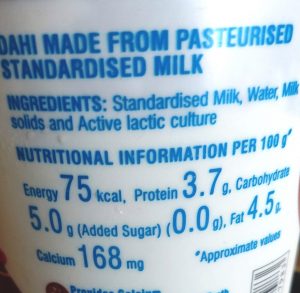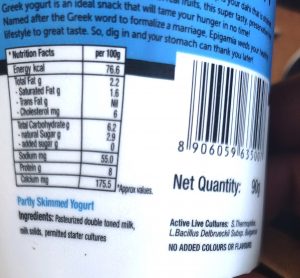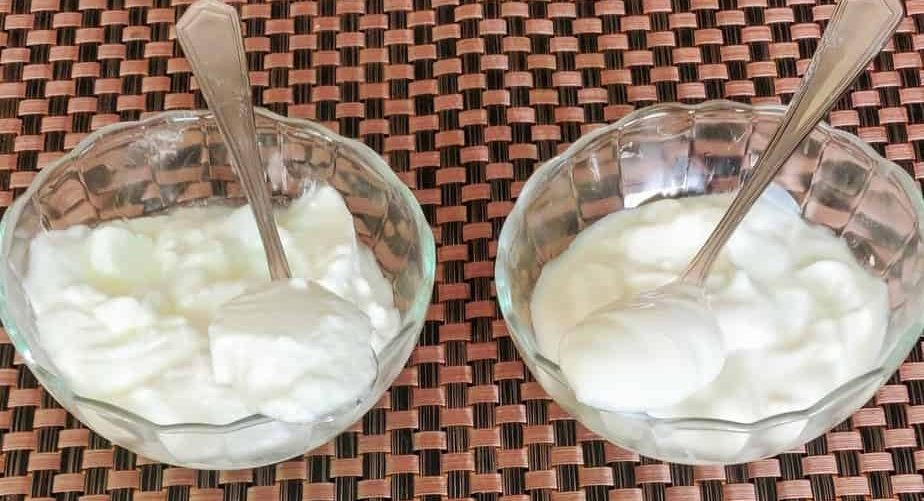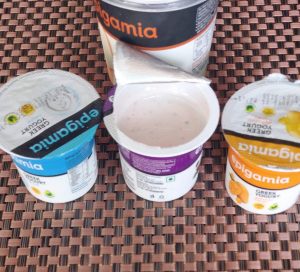Yogurt Vs Curd | What is the Difference Between Yogurt and Curd? This one question pops up in our minds every now n then. If this question bugs you too then this post is for you where you will find answers to most of your questions like:
- Is there any difference between yogurt and curd?
- How is curd different from Yogurt?
- Are yogurt and curd different?
- Is it true that Curd and yogurt are two different names of the same product? Curd is an Indian name whereas yogurt is western?
So, come, let's have a look at the answers. And I am sure, the answers to these would surely take us through a maze of exciting facts, history, food traditions, and food technology.
Since our childhood, all of us have been consuming Curd and Yogurts either directly or as part of some dish or the other. If I was to talk of India, Curd is one food which we all like and consume in different ways.
Yogurts are believed to be of west Asian origin and are largely consumed as health food forming part of the breakfast.
What is Your Opinion?
Before I proceed, tell me honestly, what is your opinion about these two products? Are these the same or different? By the way, you must have eaten both curd as well as yogurt. Now, forget the technicalities, based on your eating experience, what do you think? They taste the same or not? Also, what about the looks? Though both are white but is the texture the same? Just think about it before you scroll down.
Before we dig into their differences or similarities it is important to know about these products and understand some facts regarding them. Yes, it is a long post and I have tried to simplify the facts too. Go through these with a cool and open mind and do not forget to share your opinions too.
Yogurt and Curd
- Both Yogurt and curd are fermented dairy products that have been used as food for many centuries.
- Both are made from milk and are fermented by adding healthy bacteria to the milk.
- Why are these fermented? Simple, in the process, the nutritional value of the milk solids becomes more, and also we get more and better bacteria that can survive the journey to the Gut where it can play a more beneficial role in the digestive system.
Ok, let's pause again! In addition to curd and yogurt, there is one more very familiar term, Dahi. What's it?
Curd Or Dahi?
- When we talk of curd or Dahi then language plays a major role in adding to the confusion.
- Curd is also known as ''Dahi'' in the Indian subcontinent. In India, curd and Dahi mean one and the same thing.
- Whereas, in the western world or even as per the generic meaning, curd refers to the milk solids that remain after curdling the milk which we Indians term as cottage cheese or paneer. Thus, in India, curd means Dahi, whereas, in the west, curd means cottage cheese.
In this post, we are considering curd as Dahi only and hence trying to understand the yogurt and curd difference or say yogurt and Dahi.
What is Curd?
Curd is a very common part of Indian food and is therefore easily available everywhere. It is consumed directly or added to various preparations and is liked by people of all ages and ethnicity.
- A fermented milk product.
- Made by bacterial fermentation of milk wherein a healthy bacteria, lactobacillus bulgaricus, is added to milk which is boiled and then cooled to about 45-degree celsius.
- This bacteria is added through a spoonful of an already set curd.
- Once bacteria is added, it multiplies and in few hours liquid milk is set into thick curd.
- In the process of fermentation, lactose in milk is converted into lactic acid. It is generally made from cow's or buffalo's milk.
- The texture of the curd is though firm but at the same time slightly jiggly too.
- Also, little whey (water) is separated once it is set. Occasionally, there is a touch of sourness.
- Traditionally curd is set in earthen pots to control the sourness and reduce the whey and at the same time lending an earthen aroma.
Must Read: How To Set Curd Easily In Winters
Uses Of Curd
- Used in Puja for making Charnamrit.
- Eaten as it is in the form of curd.
- Consumed as Raita, by adding spices or vegetables and fruit to it,
- Added to make the gravy thicker as well as to enhance the taste and flavor of food.
- Make cold beverages out of it like lassi or buttermilk.
- Added to Chats
- Added to numerous vegetarian dishes in various ways during the process of cooking the same.
- Used as an egg replacer in eggless baking.
- To make many desserts like Bhapa Doi.
- Used in marinating meat, paneer, etc.
Health Benefits Of Curd (Dahi)
- Rich source of calcium and phosphorus and thus beneficial for our teeth and bones.
- Improves digestion.
- Improves immune system because of healthy bacteria in it.
- A very good hair conditioner and reduces dandruff.
- Good for skin and is added in face masks to get glowing skin.
What is Yogurt?
Yogurt is mostly consumed in West and western Asia and is a popular part of the breakfast menu. It is also popular as a health food and helps in weight loss.
- Yogurt, pronounced as yogurt or yoghurt, is a fermented milk product.
- It is made by bacterial fermentation of milk wherein at least two healthy bacteria, Lactobacillus Delbrueckii and Streptococcus Thermophilus, are added to the milk which is boiled and then cooled to about 45-degree celsius.
- In addition, some more healthy bacteria, like Bifidobacterium Bifidus, lactobacillus acidophilus may also be added to it.
- The bacteria are added to impart and influence the distinct taste, texture and, aroma, and nutritional value of the yogurt.
- Yogurts can be made from cows, buffalo, goat or camel's milk with each one having a distinct taste, texture, aroma or nutritional value.
- The texture of yogurt is smooth and creamy without any whey (water) separating from it. And its taste is sweet.
Health Benefits of Yogurt
Naural yogurt is a low-calorie, high-nutrient food packed with protein. Avoid yogurts sweetened with sugar, artificial sweeteners, or other unhealthy ingredients to avail of its full benefits. The list of its benefits is quite long, but mentioning here just a few of them:
- Aids in weight loss as it is rich in protein.
- Helps in controlling high blood pressure being rich in potassium.
- Rich in probiotics meaning it provides the gut with healthy bacteria.
- Increases the calcium and phosphorous in the dental plaque.
- Suitable for people suffering from lactose intolerance.
Different Regulations in Different Countries for Making Yogurt
Believe it or not but it's true. Different countries have laid specific regulations as to how yogurt needs to be prepared.
- India: Yogurt must contain at least two bacteria, Lactobacillus Bulgariacus and Streptococcus Thermophilus. If more than two bacteria are added then it needs to be specified on the label. Also, the bacteria should be viable and abundant in the final product. The specific lactic acid-producing bacterial count per gram shall not be less than 10,00,000 (or say 1 million). The yogurt should be smooth having thick consistency and shall be free from vegetable oil/ fat, animal body fat, mineral oil, and any other substance foreign to milk. But it may contain liquid glucose, skimmed milk powder, fruits, casein etc. Reference FSSAI standards (page 30).
- France: Regulations are more or less similar to the ones in India. However, it requires much more bacterial count. It requires at least 10 million bacteria/g.
- Germany and Spain: Once the yogurt has been made, it is usually heat-treated to kill the bacteria.
- Eastern Europe and Asia, people consume lots of milk that has undergone alcoholic fermentation by combining bacteria and yeasts (Kefir, Koumis, etc.).
- In yet other countries, various probiotics and prebiotics are added to the mix.
Yogurt Vs Curd Difference
|
Curd |
Yogurt |
|
| Bacteria | Contains only one bacteria, namely, lactobacillus Bulgariacus as the predominant strain, though more strains of bacteria may be added. | Contains a minimum of 2 strains of bacteria, namely, Lactobacillus Delbrueckii and Streptococcus Thermophilus, though more may be added. |
| Consistency | Generally thick | Can be thick or relatively more liquidy. |
| Texture | Firm but jiggly along with little separated whey. | Very smooth and creamy without any separated whey. |
| Flavors | Generally, unflavoured | Sweeteners, fruits, stabilizers, etc are added. |
| Uses | Varied uses in the culinary, therapeutic, spiritual, and beauty world | Used only for eating that too preferably in breakfast or as health food. |
| Taste | Normally constant and is slightly towards sourness. | Varies as per the bacterial culture or fruits and flavors added to it. It is generally sweet. |
| Variants | Remains standard. | Greek yogurt, probiotic yogurts, high protein, and high or low-fat yogurts, fruit yogurts, and other such variants |
| Nutrients | Protein content ranging from 9-10% | Higher protein content ranging about 13% |
| Norms And Regulations | Just one universal process of making it. | Specifications for making yogurt are different in different countries. |
| Weight loss | Has no relation with weight loss. | Aids in weight loss and is popularly known as health food. |
| Homemade | Easily made in homes. | It can also be made at home but since all the varieties cannot be made at home and thus is produced commercially too. |
| Ingredients | Store-bought curd lists milk and active lactic culture as ingredients | Store-bought yogurt lists milk, active lactic culture, and streptococcus Thermophilus both or even more as ingredients. |
Read the Labels
A look at the ingredients will make it clear to you whether it's curd or yogurt.

Ingredients listed on store-bought Curd (Dahi)

Ingredients Listed On Store-bought Yogurt
I recently tried a new brand of yogurt where the ingredients listed both lactobacillus Delbrueckii & Streptococcus Thermophilus. Apart from this, the taste too was very good. You can buy this by clicking here.
FAQ's
Q) Is there any difference in setting yogurt or curd?
Curd and yogurt both are made in the same way. In both cases, milk is first boiled and cooled until it reaches the lukewarm stage. It is important that the milk is lukewarm. If the milk is too hot then the bacteria will die and if it is too cold then bacteria will not activate and will take too long in the setting. Once it is lukewarm, it is set by adding culture to it and allowed to rest for a few hours. And this is the point when the difference between the two comes.
Q) What is culture?
- For industrial purposes, the ''culture'' refers to live bacteria whereas for household purposes, the ''culture'' refers to already set curd or yogurt as these contain specific bacteria that help in the formation of curd/yogurt. The only difference is that for making curd, curd culture is used and for making yogurt, yogurt culture is used.
- In the case of homemade curd, the "culture" for curds is mostly simply drawn from the previous preparations of curd and added to milk intended to be made into curd. Hence, it can be easily set for preparations at home itself or you can buy the curd from the market and add it to milk to set up a fresh lot for fermentation.
- Yogurt can also be set by using culture from previous preparations of yogurt.
Q) What is meant by 'Live Culture" or Active Culture?
- However, nowadays, we also have live cultures sold in the form of capsules or powder in the market. They are very expensive. I have yet to use these but I prefer using a spoonful of yogurt only for setting another batch of yogurt.
- So, after understanding the basic meaning of curd and yogurt, it's clear that these are though similar but not the same. let's see how different these are.
Q) Can Yogurts be used in place of Curd in cooking or vice versa?
- Technically, the two are not far from each other in attributes and can, therefore, be substituted for each other. However, the flavors, aroma, and taste may disturb and alter the taste and aroma of a dish that is conventionally prepared using curd, for example, Kadhi.
- I feel that though yogurt cannot be directly substituted for curd but vice versa can be done, which means that curd can be used in place of yogurt in some recipes, of course with the understanding of the difference in nutrition content.
- It would, therefore, have to be evaluated how much is a recipe sensitive to a substitution of one for the other. Care has to be taken that the yogurts do not alter substantially the taste and aroma of the main dish.
Q) Are there many different types of yogurt?
Yes, depending upon the types of bacteria cultures used, fermentation processes involved and sweeteners added to it, yogurt is of different and popular types like probiotic yogurt, low-fat yogurt, Greek yogurt, Australian yogurt and so on.
Q) What is Greek Yogurt?
Greek Yogurt is probably one of the most famous varieties in yogurts. It is thick yogurt from which all the whey (water) has been removed. Just like our desi hung curd. And because of this the protein content in Greek yogurt increases 2 to 3 times than regular yogurt. Also, it is rich in probiotics. Read more about it here.
Q) I am lactose intolerant. Can I consume yogurt or curd?
Yes. Both yogurts, as well as curd, can be easily consumed by lactose-intolerant people, as these do not contain lactose. While forming, the milk sugar lactose breaks down and is fermented to lactic acid by lactobacilli. Thus, people who can't have milk can have curd or yogurt.
Q) Are yogurt and curd vegan?
A) If made from dairy milk then none of these are vegan. In order to make it vegan, use any plant-based milk for making either of these.
Let's Connect!
Thank you for reading this post. I hope that the difference between yogurt and curd is clear to you now. Shall eagerly look forward for your inputs and views. Also, if you like this post then feel free to comment in the comment section below. You could share it in your social media circle by clicking little buttons below. You can follow me on Facebook, Pinterest, Instagram (#samirasrecipediary).
P.S. This post contains affiliate links. I may earn a small commission through this, without putting any extra cost to you, which is needed to cover the costs of running this blog.
Acknowledgments with thanks to the under mentioned sites for providing valuable information which I have collated for a better understanding.
- FSSAI Regulations(Page numbers 6 &30)
- health benefits ndtv.com
- Medical News Today
- Euromilk
- lactose intolerant ndtv.com



